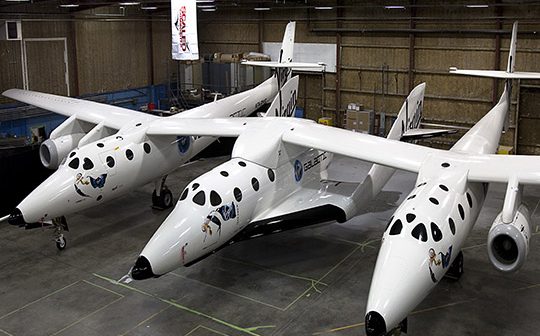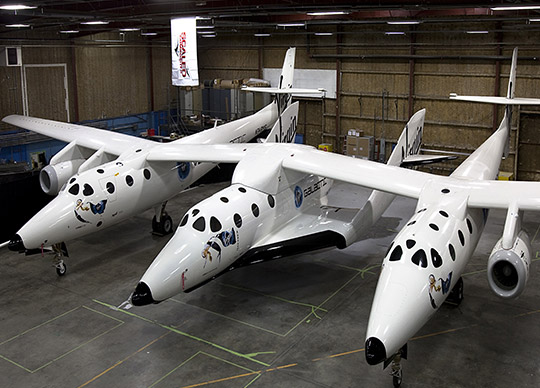
By Chris Flaherty
My Space Warfare Analysis Lab (Author Interview below)
The Scaled Composites SpaceShipTwo Spaceplane (central fuselage) resting under its mothership, White Knight Two, inside a hangar in Mojave, California, U.S. Virgin Galactic/Mark Greenberg (6 December, 2009). Virgin Galactic plans to operate a fleet of five SpaceShipTwo Spaceplanes. Each Spaceplane seats 6 passengers, and has two flight crewpersons.
SPACE TOURISM MARKET STUDIES
The Space Tourism-Adventure Industry is seen as largely dependent on a limited pool of exceptionally wealthy customers (King, 2020). Since its inception around 1998, the Industry, has been limited due to high fixed costs to enter the Space market, unless these are offset by government or a wealthy third party (Carr, 2005).
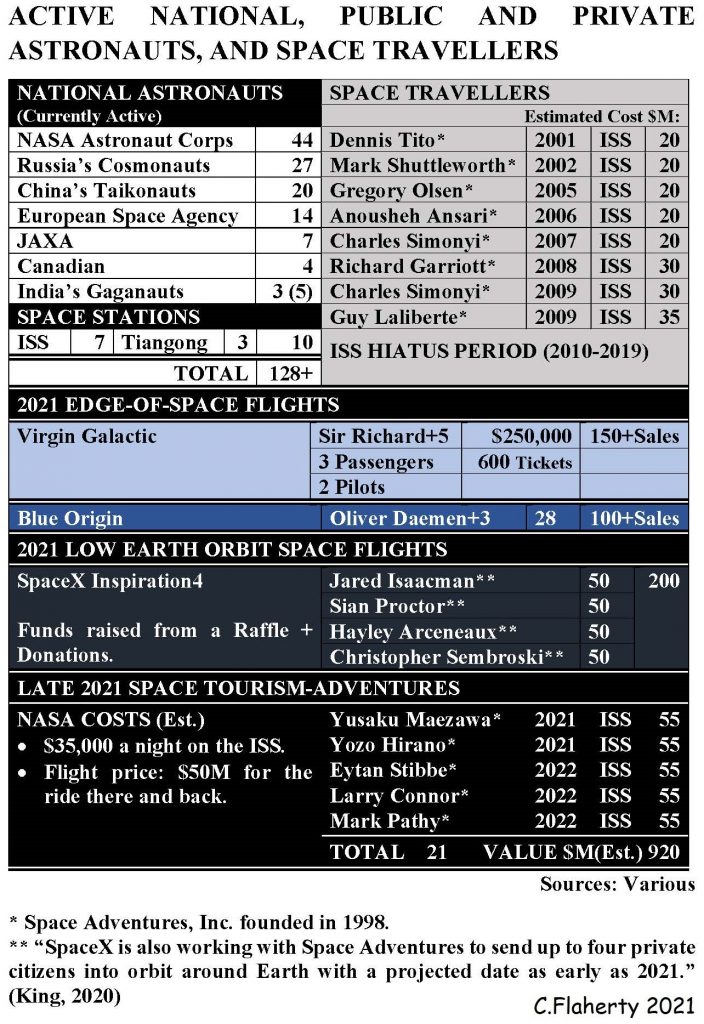
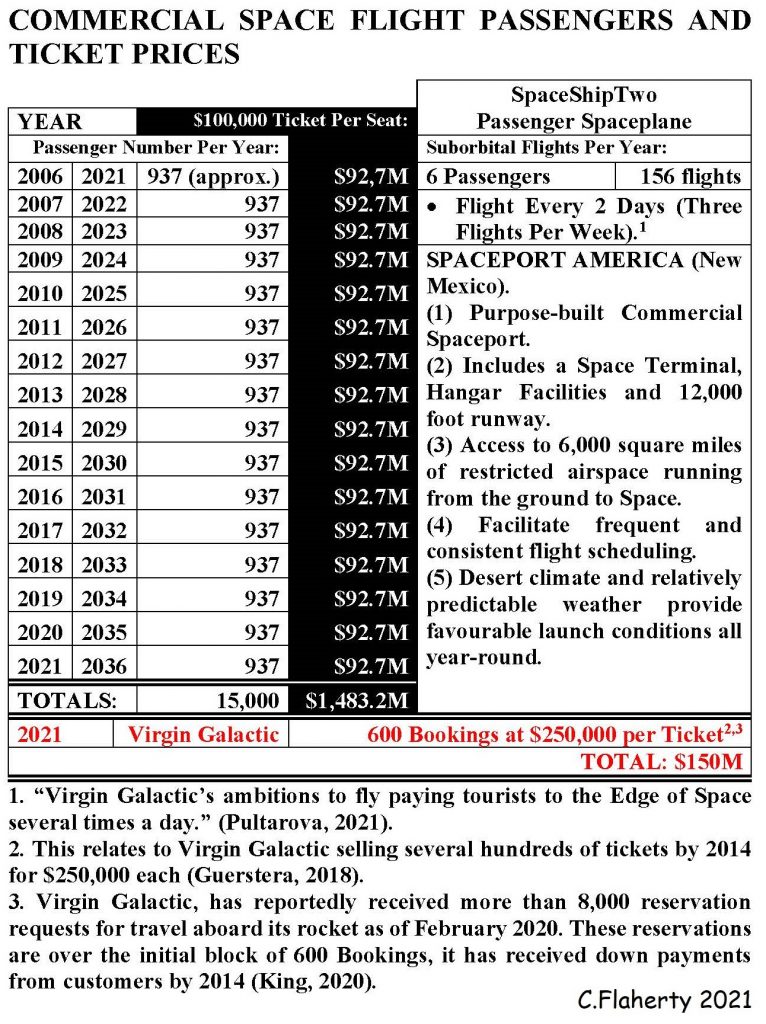
Market studies, in 2002 (Futron, 2002), then in 2018 (Guerstera, 2018), looked at the potential growth of a Space Tourism Industry from a 2006 (then adjusted to 2008) start date, till 2021. Market studies found ticket prices should follow a pattern of starting high, then briefly raising, and then declining:
| Starting in 2006-08: | First three Years: | By 2021: |
| Initial Price: $100,000 | Rise to $200,000 | Decline to $50,000 |
Economic forecasts identified 15,000 (if starting in 2006), or 13,000 passengers (if starting in 2008) by 2021. It should be noted that the later years demand would be the highest in terms of the number of people wanting a ticket:
“For the last year, 2016, the report predicts an annual passenger demand of 4,400 for a ticket price of $100,000.” (Guerstera, 2018)
The number of Space Tourism flights are predicted to rise from 10 a year, in the near future, to 360 a year by 2030 (Pultarova, 2021). The forecasts, for a 9-year period from 2021, are: “global cumulative revenues of $7.9 billion generated by 2030” (Northern Sky Research, 2021). This is based on a progressive rise in passenger figures from that suggested earlier, from a potential worldwide pool of 13-15,000, to some 41,000 passengers by 2030.
This table spreads a total of 41,000 passengers (Pax.), over nine years, flying on a 6-seat Spaceplane, with an estimated ticket price of $192,682 per seat. Some 4,555 passengers would fly into Space, per year on 759 flights, at a rate of 2-3 flights per day, all-year round.
The limiting factors on maintaining this level of commercial activity is the number of potential craft available, and the number of companies operating craft, or facilitating flights – booking agents.
| Year | Pax. | Est. Ticket Per Seat | 6 Per Flight |
| 2021 | 4,555 | 192,682 | 759 |
| 2022 | 4,555 | 192,682 | 759 |
| 2023 | 4,555 | 192,682 | 759 |
| 2024 | 4,555 | 192,682 | 759 |
| 2025 | 4,555 | 192,682 | 759 |
| 2026 | 4,555 | 192,682 | 759 |
| 2027 | 4,555 | 192,682 | 759 |
| 2028 | 4,555 | 192,682 | 759 |
| 2029 | 4,555 | 192,682 | 759 |
| 2030 | 4,555 | 192,682 | 759 |
| TOTAL | 41,000 | 7.8B | 41,000 |
It should be noted that an earlier forecast, had a compressed rate over a 7 to 8-year period, with a higher rate of passengers, and ticket sales:
- “Suborbital and Orbital tourist services beginning in 2020 and 2021, respectively, generating $14B in cumulative revenues by 2028.” (Northern Sky Research, 2019)
More recent economic analysis reporting has suggested a rise in overall ticket prices, from the Space Tourism companies, independently estimating:
- “Virgin Galactic will be raising ticket prices from $250,000 apiece to between $300,000 and $400,000, and thousands of buyers could line up.” (Hoium, 2021)
SPACE TOURISM START, HALT AND RESTART (1996-2019)
Virgin Galactic (Space Tourism Company), was founded in 2004 after SpaceShipOne, built by the company Scaled Composites and financed by the late billionaire Paul Allen, won the $10 million Ansari X Prize for Reusable Commercial Spaceflight (Gohd, 2021). The origin of the Ansari X Prize related back:
“In May of 1996, in the spirit of private growth, the Ansari X Prize Foundation announced it would award ten million dollars to the first team that privately financed, built, and launched a Spaceship able to carry three people to 100 kilometres, return safely to Earth, and successfully repeat the launch within two weeks.” (Carr, 2005)
Russia halted Orbital Space Tourism, that had started in 1998-2001, in 2010 because of an increase in the International Space Station crew size. The decision also related to the end of the Space Shuttle Program:
“Tourist visits to Space came to a halt when NASA’s Shuttle Program ended in 2011. Thereafter, American Astronauts bound for the International Space Station … were allocated seats aboard Soyuz rockets pursuant to a U.S. diplomatic agreement with Russia, leaving no extra seats to accommodate tourist passengers.” (King, 2020)
June, 2019 NASA announced starting in 2020, Private Astronauts would be going to the International Space Station (ISS) using SpaceX’s Crew Dragon Spacecraft and Boeing Starliner Spacecraft for Public Astronauts.
“In June 2019, NASA changed a long-standing policy when it announced plans to allow private citizens to fly to the ISS for short visits. It did not, however, offer to provide transportation.” (King, 2020)
CURRENT ASTRONAUT DISTINCTIONS
| Active National Astronauts Corps, Cosmonauts, Taikonauts, and Gaganauts. | Commercial Astronaut | Space Tourist Passenger | |
| Private Astronaut | Public Astronaut | ||
Inaugural Edge-of-Space Flights by Virgin Galactic, and Blue Origin had ‘Astronaut Wings’ award ceremonies – that used private companies’ badge designs. The Federal Aviation Administration (FAA), announced a major change to its Commercial Space Astronaut Wings Program, which launched in 2004. A Commercial Astronaut is a person who has commanded, piloted, or served as an active crew member of a privately funded Spacecraft. The new change: those who fly on Commercial Space Missions must also have demonstrated activities during flight that were essential to public safety, or contributed to Human Space flight safety (FAA, 2021).
Current U.S. Commercial Astronaut Wings.

THE ALAN SHEPARD EXPERIENCE
The commonly understood requirement for Suborbital Space Tourism is to take a passenger to an altitude above the Earth’s surface, at some 62.1 miles: 100 kilometres, providing them with an adventure in Space, experiencing weightlessness, view the curve of the Earth, and blackness of Outer Space. This largely attempts to replicate the 5 May, 1961 mission by Alan Shepard in the Freedom 7 Spacecraft (Capsule). It blasted-off from Cape Canaveral, Florida, on a Mercury-Redstone 3 Rocket, carrying Shepard to an altitude of 116 miles: 187 kilometres for a 15 minute Suborbital flight. The Capsule parachuted back for an ocean landing.
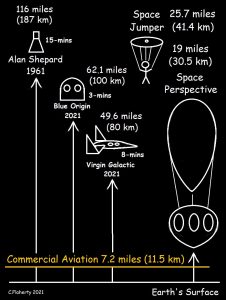 2021 Blue Origin New Shepard Spacecraft (Capsule) blasted-off, on a Reusable First-Stage Booster Rocket. Carrying to an altitude of 62.1 miles: 100 kilometres for a 3 minute Edge of Space flight. The Capsule parachuted back for a land landing.
2021 Blue Origin New Shepard Spacecraft (Capsule) blasted-off, on a Reusable First-Stage Booster Rocket. Carrying to an altitude of 62.1 miles: 100 kilometres for a 3 minute Edge of Space flight. The Capsule parachuted back for a land landing.
2021 Virgin Galactic Spaceplane, released from a aircraft mothership flew above 49.6 miles: 80 kilometres for a 8 minute Edge of Space flight, and then glided-back to an airstrip.
EXPERIENCING WEIGHTLESSNESS ADVENTURES
Space Adventures operates a modified Boeing aircraft that takes off from a runway, reaches a certain altitude, and performs a manoeuvre in the shape of an arc that allows passengers aboard to feel intense pressure almost twice that of normal gravity on the way up followed quickly by less than a minute of weightlessness near the top of the arc. The feeling is said to be similar to what an Astronaut feels in the microgravity environment of the International Space Station. The aircraft performs this manoeuvre several times within airspace designated by the Federal Aviation Administration (FAA). The experience costs about $5,400 per passenger (King, 2020).
FUTURE SPACE TOURISM–ADVENTURES
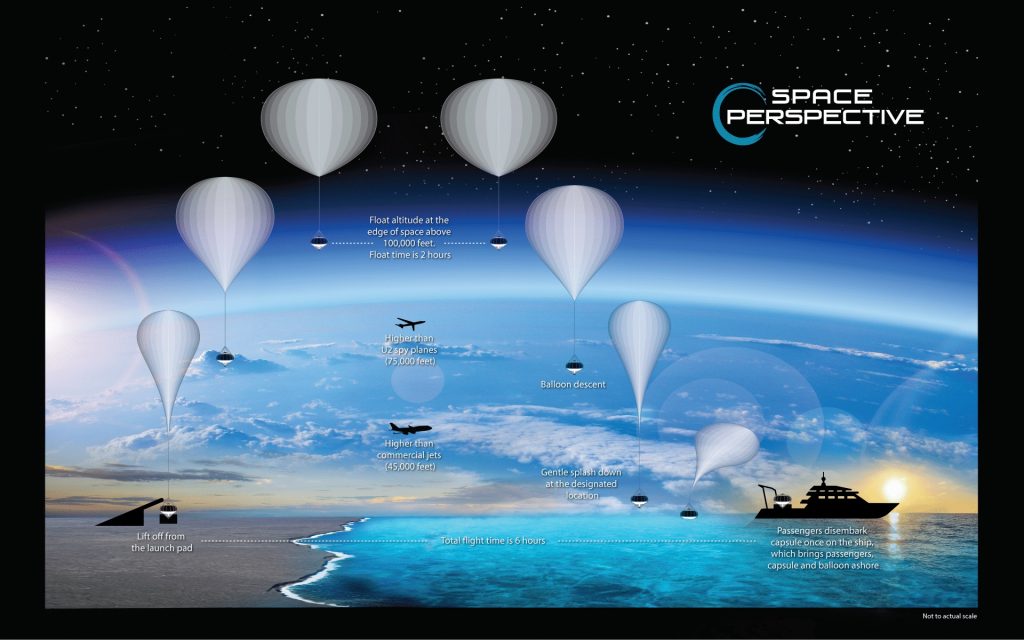
Spaceship Neptune Flight Plan (Space Perspective, 2021).
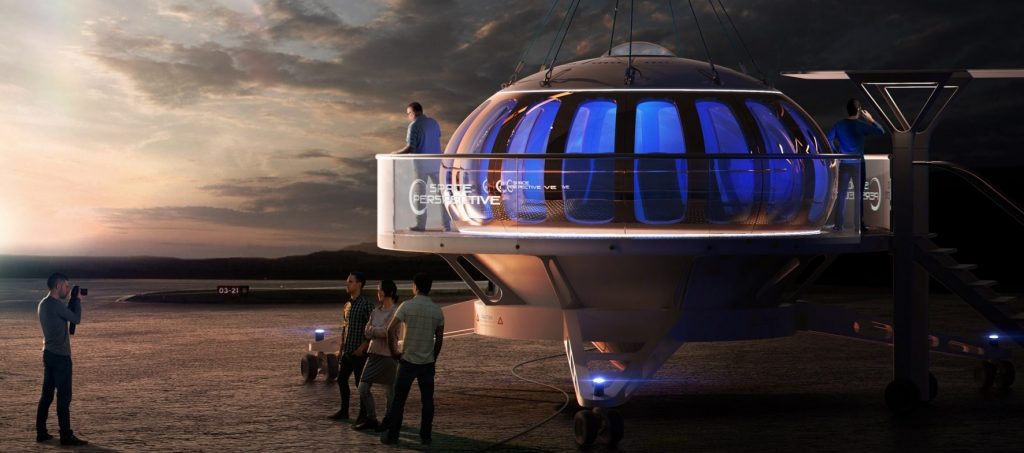
Spaceship Neptune (Space Perspective, 2021).
Space Perspective, a Florida-based private company was created in June 2020. The company has been accepting seat reservations for its Spaceship Neptune, a pressurized capsule, carried to an altitude of nearly 19 miles: 30.5 kilometres, using a high-altitude gas-filled football-field-sized balloon. Designed to carry eight passengers and one pilot. The price is $125,000 per seat. Initially operating from a base in Florida. Passengers can expect to view the curve of the Earth and blackness of Outer Space, far above the altitudes at which commercial airplanes normally fly (around 7.2 miles: 11.5 kilometres). The balloon descends after a several-hour journey by gradually releasing its gas, to land at sea for a recovery (King, 2020; Wall, 2021).
SPACE DIVING-JUMPING
Space Diving-Jumping, are extreme high-altitudes skydives that require a specialised suit, or capsule and suit combination, and use a high-altitude balloon to make the ascent:
Space Diving Records (1959-2014):
| 1959 | Joseph Kittinger | 14.4 miles | 23.2 kilometres |
| 1960 | Joseph Kittinger | 19.4 miles | 31.3 kilometres |
| 2012 | Felix Baumgartner | 24.2 miles | 38.9 kilometres |
| 2014 | Alan Eustace | 25.7 miles | 41.4 kilometres |
REGULATING SPACE TOURISM
The Space Tourism-Adventures Industry is still in its beginnings, and so far not a great deal of regulations, or laws have been designed. In the case of,
“The U.S. government currently has no procedures for certifying the safety of launch vehicles or Space travel for tourists. An exhaustive certification process exists for Commercial Spacecraft transporting NASA Astronauts, but the same standards have not been formally required of Space vehicles for tourist use.” (King, 2020)
It is also unclear whether NASA will insist that Private Astronauts and Space Tourists visiting the International Space Station, in late 2021, will need to meet the same medical and training requirements as NASA Astronauts aboard the Station (King, 2020).
ENVIRONMENTAL ISSUES OVERVIEW
Researchers have attempted to assess the impact of Stratosphere pollution from rocket exhaust (Pultarova, 2021). Environmental concern is that increasing launch frequencies, and accumulating effects could cause harm by injecting pollutants into the Stratosphere. There is already a permanent layer of carbon in the atmosphere at the flight level of aircraft. Particles from rocket motors will likely create a secondary level in the Stratosphere.
It has been theorize, that rocket motors burning hydrocarbon fuels generate soot. Soot absorbs ultraviolet light, and this could possibly heat the Stratosphere, potentially changing its motion. Future harm may come in altering the polar jet stream, change winter storm patterns or affect average rainfall. Soot particles generated by hybrid rocket engines are extremely small and light-weight, and the particles could stay in the Stratosphere forever. Solid fuel rocket engines used for boosters burn metallic compounds emitting aluminium oxide particles together with hydrochloric acid, both of which have a damaging effect on the atmosphere. For instance, there was a measurable impact from the Space Shuttle’s solid fuel boosters on ozone depletion in the Stratosphere. Rockets generating ozone-damaging substances continue to launch currently.
The potential problem is rocket engine burns pollute the higher layers of the atmosphere in the Earth’s Stratosphere at an altitude of 6.2 miles: 10 kilometres, and the Mesosphere at an altitude of 31 miles: 50 kilometres. Emitting pollutants in a place where these are not normally emitted. So far, the impact of rocket launches on the atmosphere is negligible. The amount of fuel currently burned by the Space Industry is less than 1% of the fuel burned by Aviation. However, a Suborbital Space Tourism flight, lasting about an hour and a half, can generate as much pollution as a 10-hour Trans-Atlantic Flight.
AUSTRALIAN SPACE TOURISM-ADVENTURES
Having looked at the overall structure of the current Space Tourism-Adventures Industry, how does this translate into Australia? There are several possibilities:
- Have booking agents operating in Australia to facilitate individual and group tours to the U.S. to take a Space Tourism-Adventures flight.
- Establish an Astronaut Training Facility to prepare Private and Commercial Space Travellers for their flight in the U.S. The same facility could be used for advanced training and research for developing AustNauts (Australian National Astronauts Corps), as well as Defence, Commercial, Public and Private Astronauts, and Space Travellers.
- Oliver Daemen at 18, is the youngest person to go into Space. Professional Astronauts are in their mid-30s (the average age is 34), and Allan Shepard was 38 when he first went into Space, and was 47 when he set foot on the Moon. Many nations are now looking to create a Space Generation. Some of the issues, are: (1) How young can a person be trained, and prepared to go into Space; (2) Using Commercial Space Flights to gain experience.
- Advanced Australian Space Tourism-Adventures Industry would require a Spaceplane Runway, which would also serve Commercial and Defence needs in terms of access to Space Stations, and Space Factories, sending up horizontal launch missions, and landing craft (Virgin Galactic). There would also need to be a fixed launching pad for Vertical Launch Systems (Blue Origin).
- Could see seasonal Space Jumping and Stratospheric Balloon tours and research activities.
- A Spaceport Australia approach, and development of an Australian Space Mission Control, is linked with the National Space Tracking System. Australia’s established Space Tracking Network is part of the trans-global system that has been used since the original Moon landings, and will be instrumental in the next block of Moon and Mars Human missions.
- Integrated with land and air transport system. As most of Australia’s Space activities would take place in the open interior in relation to its three inland Spaceport sites, linked to a mobile-launch land corridor traversing the continent South to North.
REFERENCES
- Carr, C. 2005 The Economics of Space Tourism: NASA and the Entrepreneur. Duke Journal of Economics. Volume XVII (Spring).
- King, A.K. 2020 The Future of Space Tourism. Analyst in Transportation Policy. Congressional Research Service Reports (28 August). R46500
- 2002 Space Tourism Market Study: Orbital Space Travel & Destinations with Suborbital Space Travel. Futron Corporation (October).
- Gohd, C. 2021 Virgin Galactic Launches Richard Branson to Space in First Fully Crewed Flight of VSS Unity. Scientific American; SPACE.com (12 July).
- Guerstera, M. Crawleya, E. de Neufvilleb, R. 2018 Suborbital Space Tourism – A Commercial Feasibility Assessment. 69th International Astronautical Congress (IAC), Bremen, Germany (1-5 October).
- Hoium, T. 2021 Who Is Going to Pay $300,000 for a Ticket to Space? More People Than You Might Think. The Motley Fool (18 July).
- Northern Sky Research. 2021 Space Tourism and Travel Markets. 2nd Edition (January).
- Northern Sky Research. 2019 NSR Report: Space Tourism Market Ready to Take Off. Press Release (17 December)
- Pultarova, T. 2021 The Rise of Space Tourism Could Affect Earth’s Climate in Unforeseen Ways, Scientists Worry. Space.com (July).
- Sheetz, M. How SpaceX, Virgin Galactic, Blue Origin and Others Compete in the Growing Space Tourism Market. CNBC (26 September).
- Space Perspective. 2021 Fact Sheet.
- S. Department of Transportation. Federal Aviation Administration. National Policy. FAA Commercial Space Astronaut Wings Program. ORDER 8800.2. Effective date: 07/20/2021
- Wall, M. 2021 Space Perspective Starts Selling Seats for Balloon Rides to Stratosphere. Space.com (24 June).
AUTHOR
Chris Flaherty authored the Terrorism Research Center’s report – Dangerous Minds (2012). He was the co-primary author, along with Robert J. Bunker of the book – Body Cavity Bombers: The New Martyrs (iUniverse, 2013). Two essays of his, from 2003 and 2010 were reprinted in the Terrorism Research Center’s book – Fifth Dimensional Operations (iUniverse, 2014). He recently contributed a book chapter – The Role of CCTV in Terrorist TTPs, edited by Dave Dilegge, Robert J. Bunker, John P. Sullivan, and Alma Keshavarz, the book – Blood and Concrete: 21st Century Conflict in Urban Centers and Megacities, a Small Wars Journal anthology, published on behalf of the Small Wars Foundation with Xlibris (2019). Chris Flaherty is currently a Space & Defense Tech and Security News Regular Contributor.
CONTACT DETAILS: Dr Chris Flaherty https://au.linkedin.com/in/drchrisflaherty

